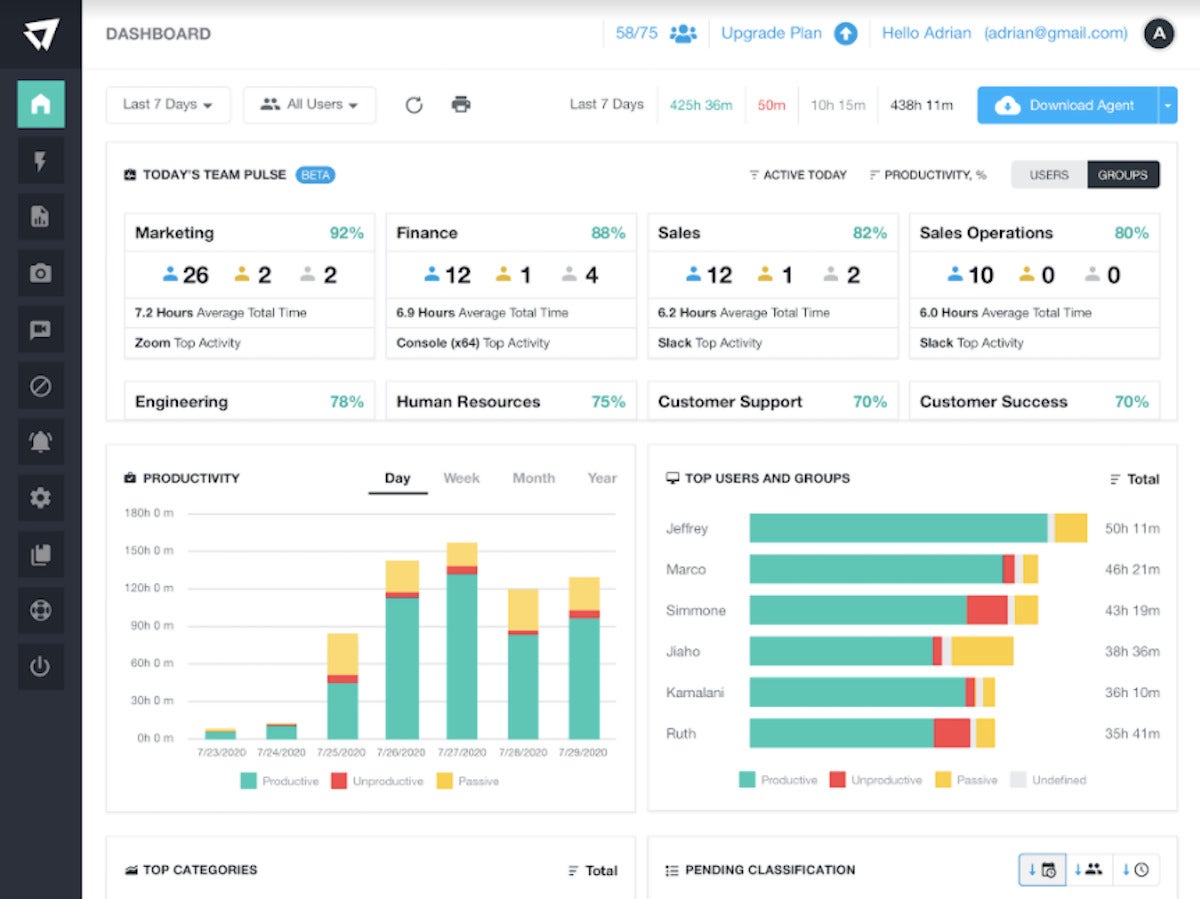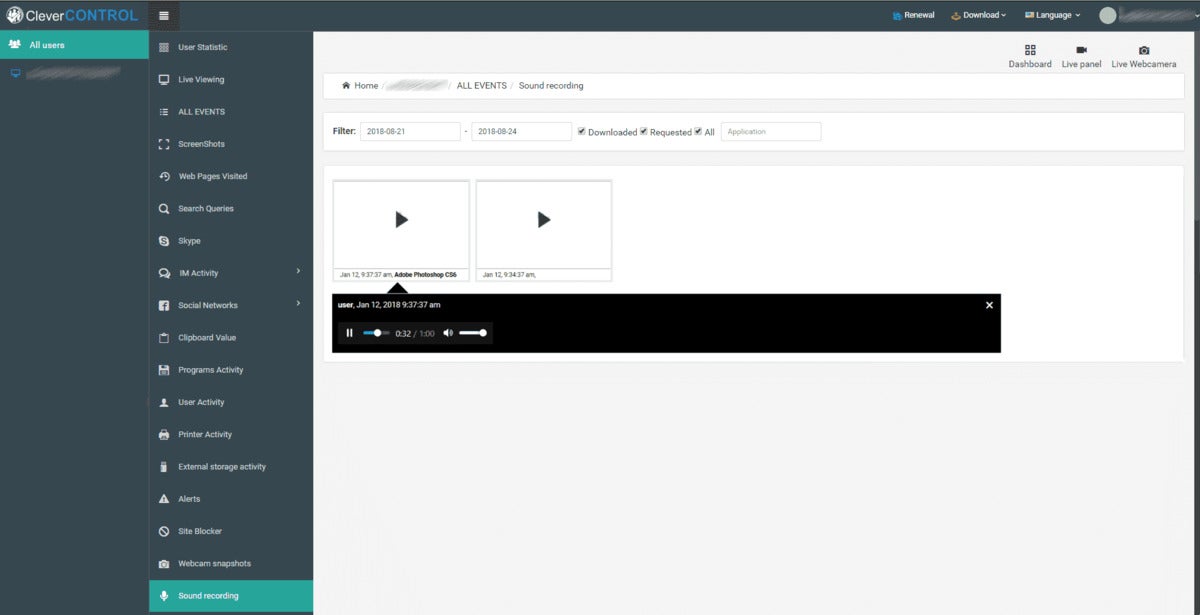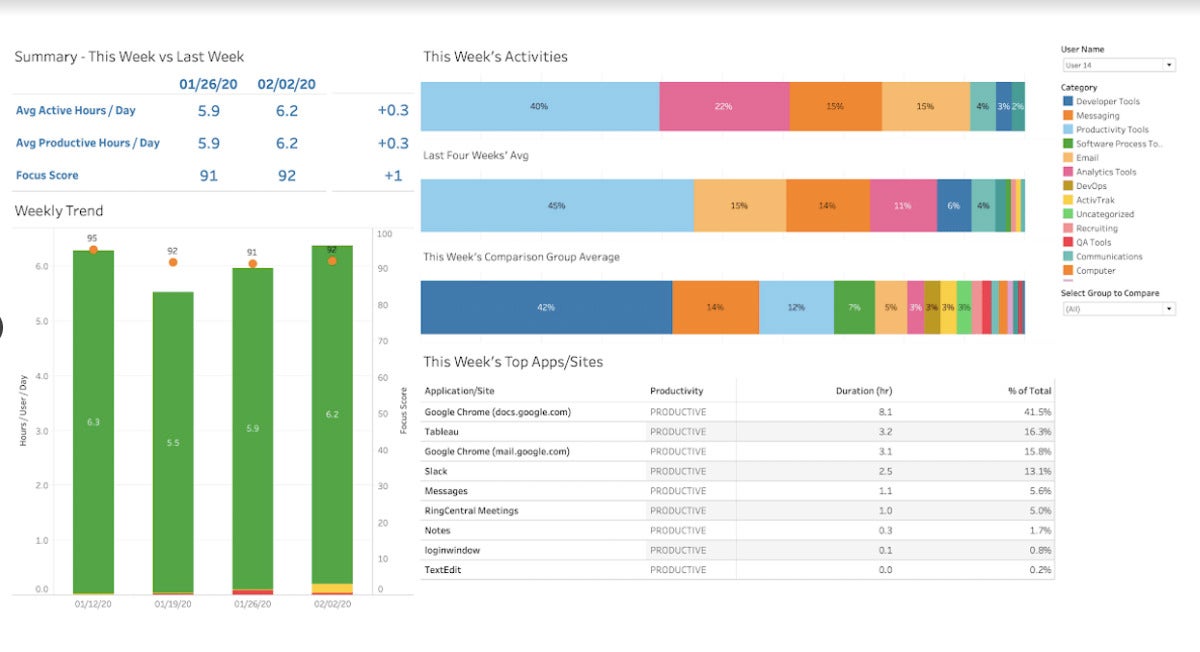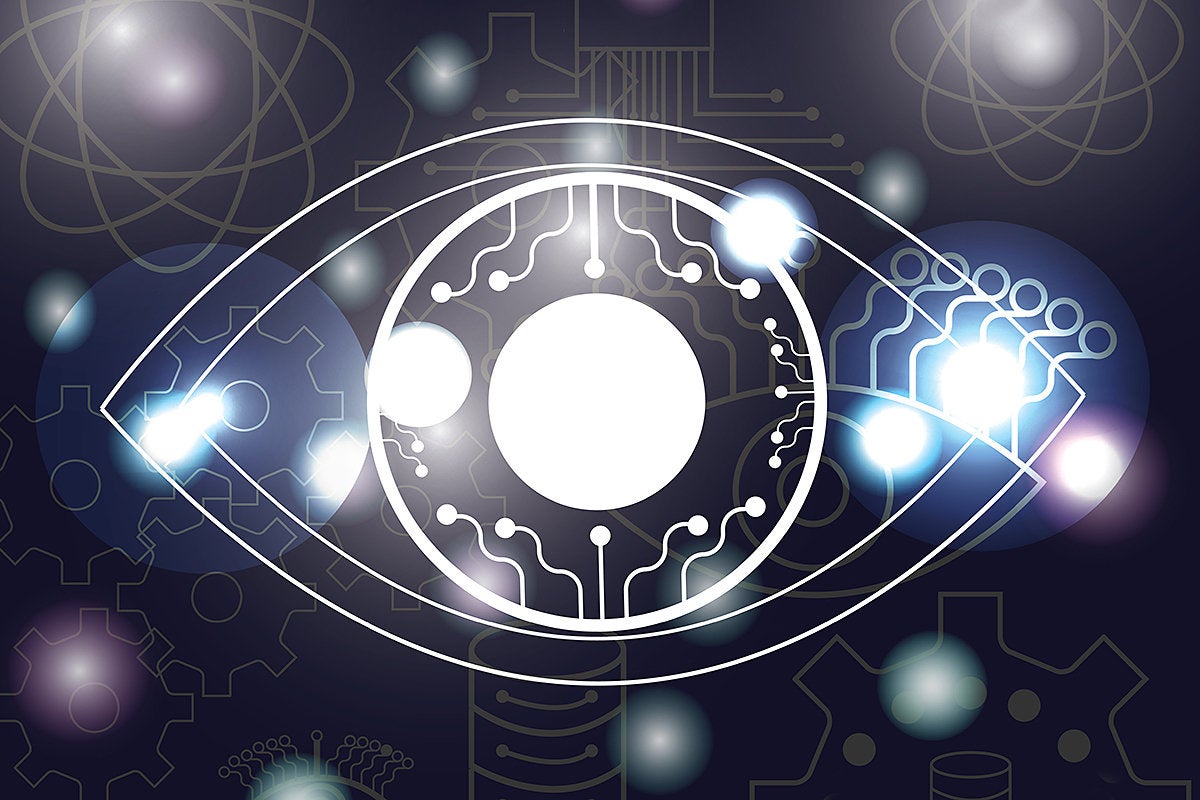In the midst of a pandemic that’s led to unprecedented levels of remote working, digital tools to monitor employees in real time are gaining popularity among companies looking for new ways to track employee productivity. At the same time, the trend raises concerns about employee privacy and how far companies should be allowed to go to keep tabs on their workers.
Applications such as StaffCop, Teramind, Hubstaff, CleverControl, and Time Doctor include real-time activity tracking, can take screenshots of workers’ computers at regular intervals, do keystroke logging, and record screens. In some cases, the tracking tools can be installed without the knowledge of employees. Companies say they’re focused on transparency and productivity, but privacy groups decry draconian “Big Brother” moves made possible by technology. (Computerworld reached out to several of the vendors for comment; most either did not return messages or could not provide someone to discuss their software.)
As COVID-19 spread earlier this year, forcing workers out of the office and into ad hoc work-from-home setups, the installation of tracking software on employee devices “dramatically accelerated,” said Brian Kropp, group vice president for Gartner’s HR practice.
“When COVID-19 hit, we found that within the first month, 16% of companies put new tracking software on the laptops of their remote employees,” said Kropp, who has done research on post-COVID-19 workplace trends. By July, the number had risen to 26% of companies.
“We were already moving in this direction of passively monitoring our employees, listening to them and watching them, and asking them less and less,” said Kropp. “What the pandemic has done is just accelerate the speed at which that is happening... They were going to get there eventually; the pandemic has just accelerated the future into the present.”
Phoebe Moore, associate professor of Political Economy and Technology at Leicester University in the UK, echoed Kropp and sees potential privacy concerns for employees.
“Frankly, yes, it is on the rise,” said Moore, who is working on a research project involving workplace surveillance for the EU Parliament. “Whether or not it's necessary is another question, but it's definitely happening. There's a lot of new purchases in this software arena, a lot of new investment, a lot of new experimentations. And I think this is a bit of a shift to these at times invasive practices.”
Employee monitoring: How we got here
Employee monitoring to improve efficiency is not new, with conflicts over what should be prioritized: the rights of employers to see what their workforce is doing or an employee’s right to privacy and autonomy.
Keeping an eye on employees pre-dates the information age; companies have long gravitated toward efforts to boost economic efficiency through worker productivity, a key tenet being the close monitoring of workers to hone and fine-tune work processes.
 StaffCop
StaffCop
StaffCop lets admins monitor employees via live video feed using their computer’s webcam.
While often effective — the assembly lines at Ford factories a century ago are a notable example — the approach has also proved controversial because it can increase worker stress. In recent decades, as work shifted from the industrial to the information age, techniques to track employees evolved with new technologies.
The trend has been evident in jobs that require physical work, such as in manufacturing and warehouses. Amazon, for example, has drawn scrutiny for its automated tracking of fulfilment center workers, with reports of firings based on the productivity metrics gathered.
White-collar jobs are monitored as well; the recording of internet history, email messages and location have been done for many years. A 2007 survey by the American Management Association showed that 66% of employers monitored internet connections; 45% tracked keystrokes; content and time spent at the computer; 43% stored and reviewed computer files; and 10% even monitored employee social media accounts.
“Every single industry has some form of identification of workers’ activity,” said Moore. “The difference now is maybe you could ask the question of which industries are using [it] more, and which industries are under the spotlight. Whereas once upon a time a manager stood with a clipboard and kept track of what people were doing on the shop floor, now you're seeing this in the office space, where every time you use a digital platform there's data that's being gathered about you.”
More advanced software now allows companies to build a picture of the internal workforce faster and in more detail. A 2018 Gartner survey of 239 large corporations found that more than 50% were using some type of “non-traditional monitoring techniques” such as email monitoring and location analysis, up from 30% that did so in 2015. The expectation at the time was that that figure would reach 80% by 2020.
“What we saw beginning to occur about four years or so ago are companies experimenting with new technologies to track and understand their employees,” said Kropp. “We've seen companies monitoring employees' internal emails and using those to get sentiment analysis. We saw companies using organizational network analysis by examining the calendars of employees to try to understand who they meet with, who are most important people in the company, and so on.”
Despite concerns around privacy, digital employee monitoring has largely become an accepted practice in measuring performance at work — just as the use of fitness trackers to monitor training or daily step counts has become common.
For Human Resources departments, analytics applications can provide performance insights across an organization’s workforce, help identify talent, and offer insights on where employees may need more support.
 ActivTrak
ActivTrak
ActivTrak gives a detailed breakdown of where employees spend their time, labelling certain apps and websites as productive or unproductive.
Most modern digital productivity tools offer a range of metrics at the team or individual levels. For example, Microsoft, the biggest productivity software vendor, has a dedicated tool for tracking behavior — Workplace Analytics — that is used by the likes of Vodafone and Unilever to tap into Office 365 data, offering behavioral insights such as the number of emails a person sends each day. (Microsoft also has an app, MyAnalytics, that lets individual workers track their own productivity.)
Google’s Work Insights feature provides analytics to track collaboration patterns in Workspace (formerly G Suite) such as time spent in meetings, with an aggregate view of at least 10 workers. And, though not necessarily a gauge of actual productivity, Slack’s analytics can highlight which employees have sent the most messages in a particular time period.
The new breed of monitoring tools
More recently, there has been an uptick in the use of apps that monitor behavior proactively and much more precisely. Dubbed “bossware” by critics, the software has drawn criticism this year as being overly invasive.
Once installed on an employee’s computer, these tools can continuously monitor and record activity at a granular level and record the screens of users. In some cases, it’s possible to do this without an employee’s knowledge.
 ClverControl
ClverControl
With CleverControl’s software, admins can record audio from an employee’s microphone and speakers to monitor conversations during a call.
“In the last couple of years, we've seen [monitoring] go one step further, where there's software that you can install on your employees’ laptops,” said Kropp.
“They track the speed at which [employees] type, can take pictures of you with your camera on your laptop, and can then align all of that data to get a sense of: Are you really as productive as you were? Are you slowing down? Are you exhausted? Are you burnt out? All sorts of metrics from that perspective.”
Productivity tracking is just one rationale for using monitoring software. Software vendors also argue that their tools can be used for insider threat detection, with the ability to automatically notify admins or managers about potentially malicious activity and anomalous behavior.
But measuring productivity is a key priority.
Though capabilities differ between products, all enable granular tracking of employee actions across a laptop, PC and often mobile devices. Common features include:
- Activity monitoring of websites and applications, with admin alerts for banned sites or apps
- Analytics dashboards that provide an overview of where time has been spent and whether it is productive or unproductive
- Regular screenshots and continuous video recording
- Recording of audio from a device’s speakers and microphone
- Keystroke logging to track every individual keystroke across any software application
- History logs and video playback
In response to critics that see employee monitoring techniques such as video recording and keylogging as invasive, a StaffCop spokesperson said concerns vary: “We sell our solution worldwide and approach to employee monitoring significantly varies from region to region. The best practice here is to include chapters defining the conditions (and applied capabilities) of usage of employee monitoring software in labor contracts.
"If an employer and the employees define that those functions should [not] include keylogger or videofeed — these functions are turned off in the software," he said.
One company offering monitoring and analytics, Austin, TX-based ActivTrak, bills itself as a less-intrusive alternative to other monitoring tools, with a focus on individual and team workforce analytics. Founded in 2012, ActivTrak features granular data reporting and can collect automated screenshots. But it forgoes more invasive capabilities such as keystroke logging and live video recording.
“We look at our offering as a workforce analytics and productivity management platform,” said ActivTrak CEO Rita Selvaggi. “It gives both employees and employers an opportunity to see how work is done and improve the processes to get that work done.”
The company looks to provide customers with a data-backed overview of employee performance, said Selvaggi, identifying process bottlenecks and drawing a clear picture of how work gets done. The ActivTrak agent can be installed on an employee’s computing device, reporting data gathered back to servers hosted in Google’s cloud. Data insights are viewable by managers and team members, with a “team pulse” feature providing a daily summary of which team members are the most productive.
 ActivTrak
ActivTrak
ActivTrak customer York International uses the Data Connect feature to send user data to Microsoft’s PowerBI visualization tool, offering senior leaders a snapshot of workforce productivity.
ActivTrak also integrates with external business intelligence providers, with its Data Connect platform letting customers export data to PowerBI, for example, or correlate ActivTrak data with CRM or HR platforms for deeper analysis. Doing so can identify best practices among top-performing workers, said Selvaggi.
“We believe that the value of what we can bring to customers is in the data,” she said. “By understanding insights about how employees work, you can derive improvements in productivity, you can actually make work more enriching — all of those types of side benefits from using the data.”
The software should be used to support workers, not control them via intrusive monitoring, she argued. “As long as you have these guiding principles on how that data is to be used, it shapes the value of the platform,” Selvaggi said. “Insight versus oversight is an important mantra for us; data should be insightful, and it should not necessarily be used for oversight or monitoring alone.”
With that in mind, Selvaggi said the company proactively works with customers to consider their use of employee data before rolling the platform out. “We have expanded our onboarding team so that our team has very deliberate walkthroughs with new customers to take them through: ‘How do you roll out the product? How do you look at the data? How do you organize the data? How do you bring employees into the conversation?’ — all of those things,” said Selvaggi. “We expect that to continue and grow in the coming year, because we think there’s huge opportunity for managers to be better enabled as coaches with employees, leveraging the data for that purpose.”






